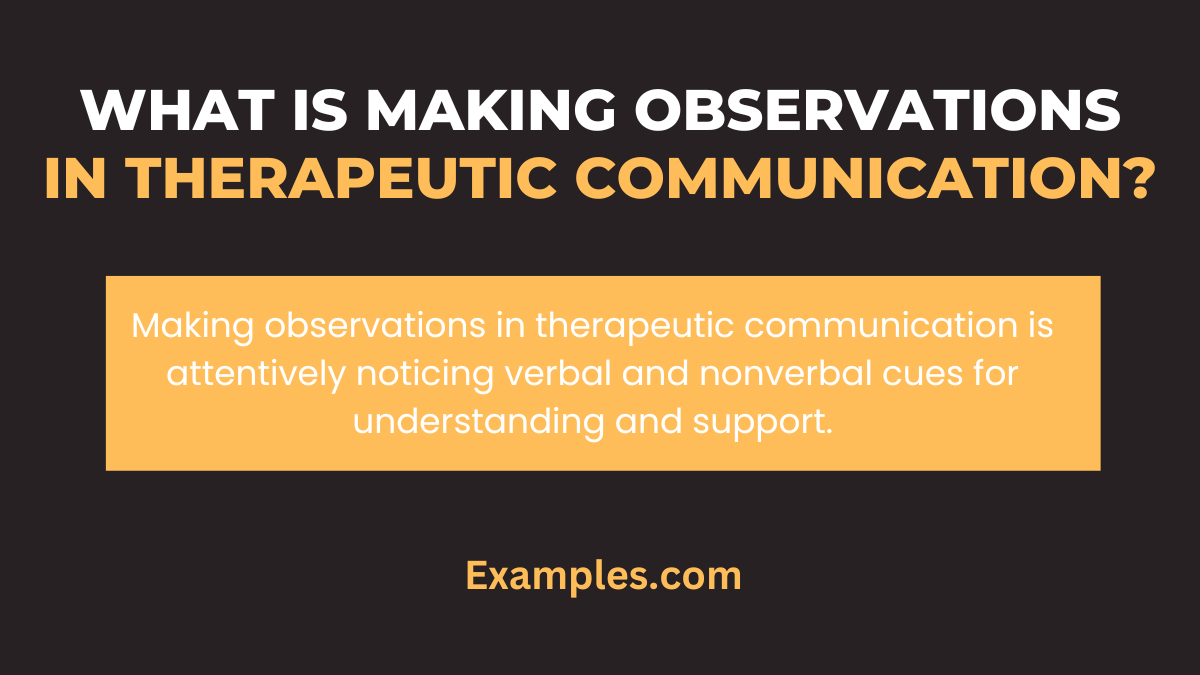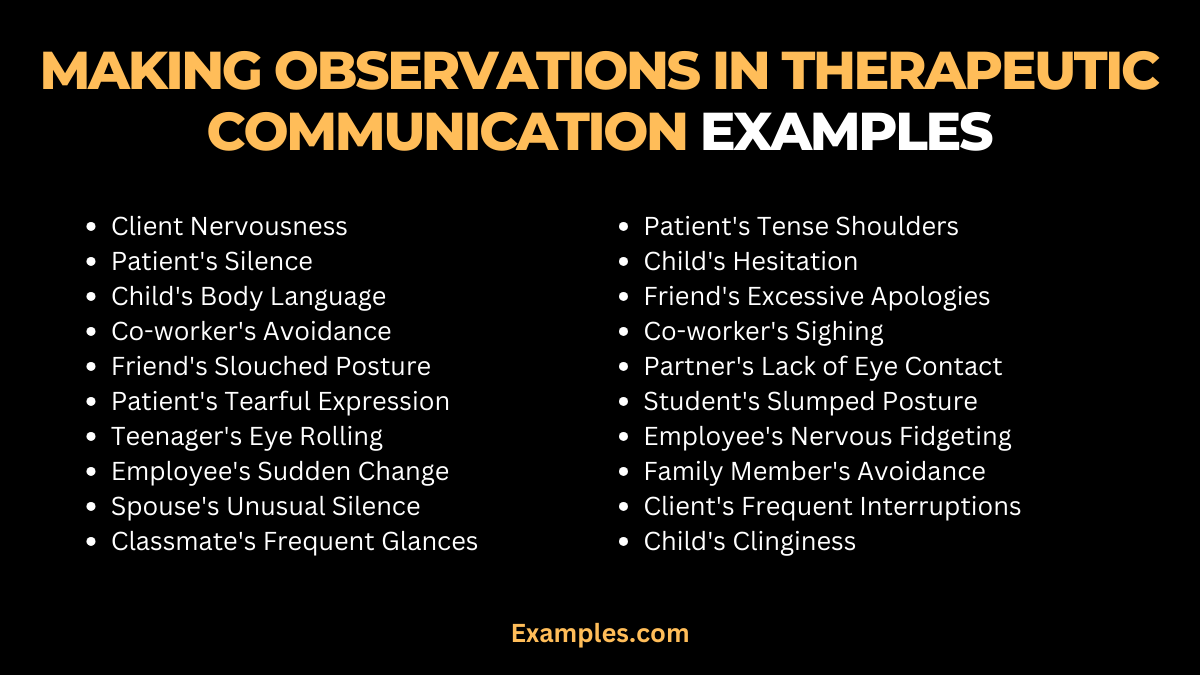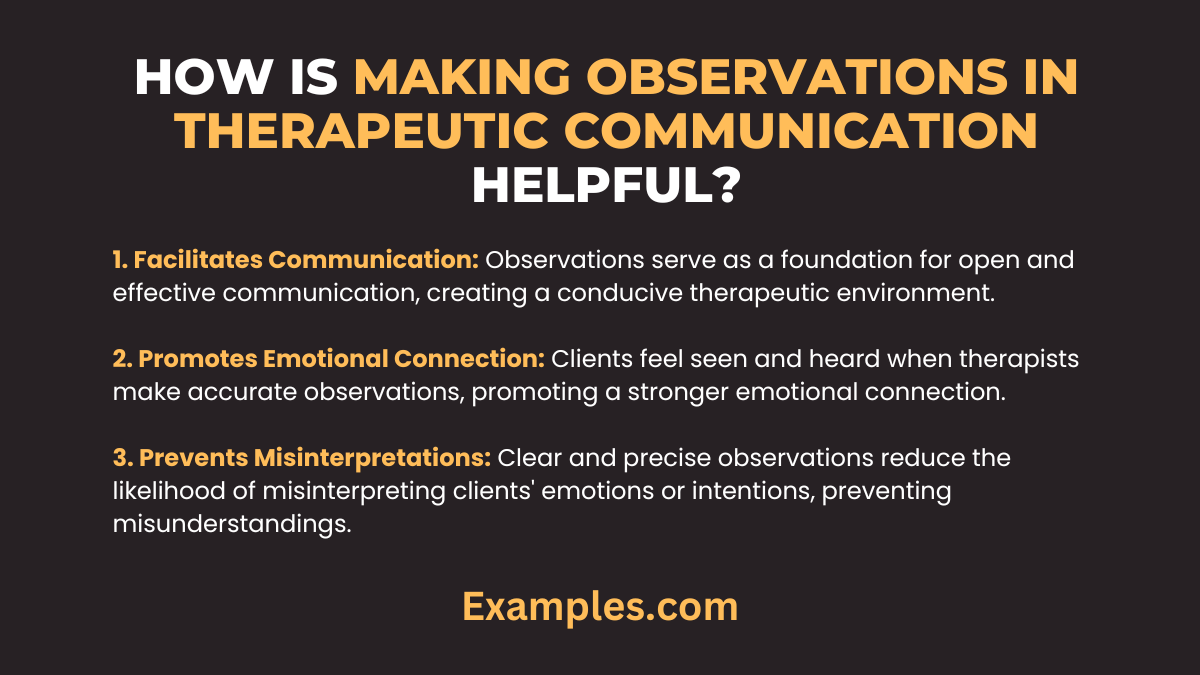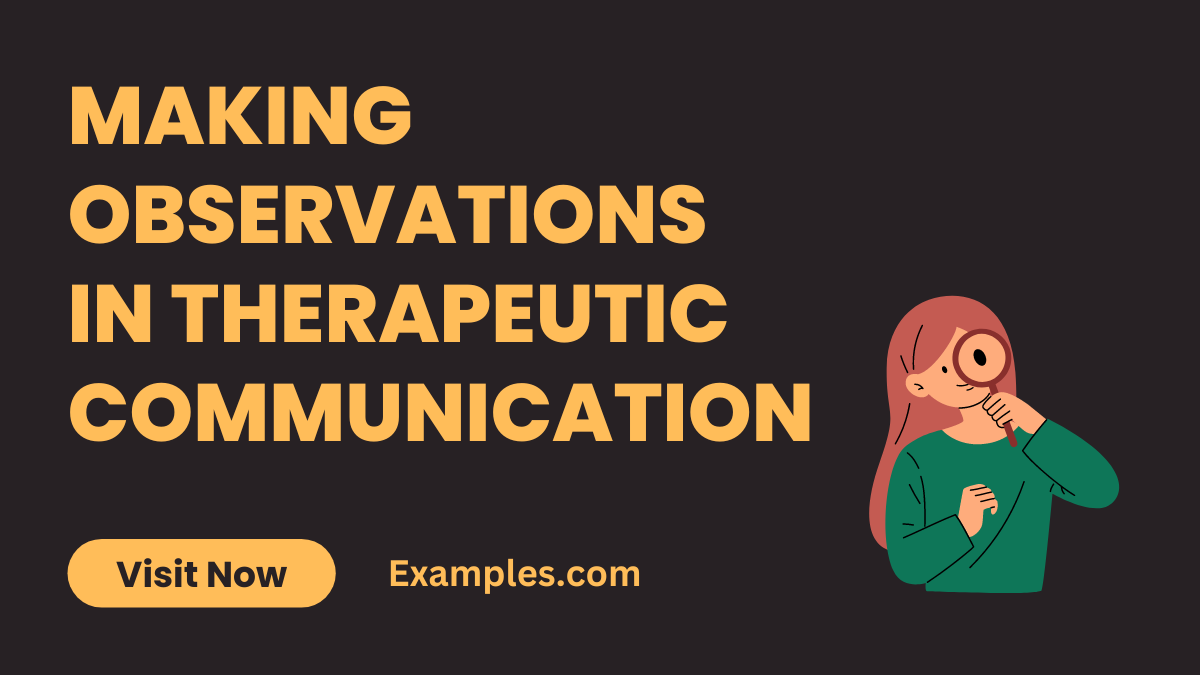Making Observations in Therapeutic Communication – 19+ Examples
Unlock the power of effective therapeutic communication with Making Observations. This comprehensive guide delves into the art of keen observation, offering valuable insights and practical strategies to enhance your communication skills. Immerse yourself in engaging Communication Examples that illuminate the path to a deeper understanding of others, promoting meaningful connections and fostering a supportive environment. Elevate your communication prowess through the mastery of observation with this insightful guide.
What is Making Observations in Therapeutic Communication?

Making observations in therapeutic communication involves the skillful and attentive examination of verbal and nonverbal cues during interactions. This technique enables communicators, such as therapists or caregivers, to discern underlying emotions, thoughts, or concerns. By astutely noting nuances in behavior, tone, and body language, observers can gain profound insights into individuals’ experiences, facilitating a more empathetic and tailored approach in therapeutic settings.
20 Making Observations in Therapeutic Communication Examples

Making observations in therapeutic communication is a vital skill for discerning unspoken cues, fostering deeper connections. This technique involves keenly noting verbal and nonverbal expressions, offering valuable insights into emotions and thoughts.
- Client Nervousness: “Your fidgeting suggests nervousness. Can we explore what might be causing it?”
- Patient’s Silence: “I notice prolonged silence. Is there a specific topic or feeling you’d like to discuss?”
- Child’s Body Language: “The child’s crossed arms indicate discomfort. Let’s create a more welcoming environment.”
- Co-worker’s Avoidance: “Your avoidance of eye contact raises concern. Can we address any work-related issues?”
- Friend’s Slouched Posture: “Your slouched posture hints at fatigue. Would you like to share what’s on your mind?”
- Patient’s Tearful Expression: “I see tears; it seems emotional. Would you like to talk about what you’re feeling?”
- Teenager’s Eye Rolling: “The eye-rolling suggests frustration. Let’s discuss any challenges you’re facing openly.”
- Employee’s Sudden Change: “Noticing a change in behavior. Is there something happening at work we should address?”
- Spouse’s Unusual Silence: “Your quietness is noticeable. Can we explore any concerns or feelings you’d like to share?”
- Classmate’s Frequent Glances: “Frequent glances our way. Is there something you’d like to add to the discussion?”
- Patient’s Tense Shoulders: “Tense shoulders may indicate stress. Would you like to discuss what’s on your mind?”
- Child’s Hesitation: “Noticing hesitation. Is there a particular activity or topic you’re uncertain about?”
- Friend’s Excessive Apologies: “Excessive apologies may suggest distress. Let’s talk about what’s bothering you.”
- Co-worker’s Sighing: “Frequent sighs are noticeable. Is there anything causing frustration or discontent?”
- Partner’s Lack of Eye Contact: “Your avoidance of eye contact stands out. Is there something you’re uncomfortable discussing?”
- Student’s Slumped Posture: “Slumped posture signals disengagement. Let’s explore ways to make learning more engaging.”
- Employee’s Nervous Fidgeting: “Nervous fidgeting is evident. Is there something about the project that’s causing anxiety?”
- Family Member’s Avoidance: “Avoidance is noticeable. Can we address any unresolved issues or concerns within the family?”
- Client’s Frequent Interruptions: “Frequent interruptions during sessions. Let’s discuss ways to ensure effective communication.”
- Child’s Clinginess: “Clinginess may indicate insecurity. Can we explore activities to build confidence and independence?”
Making Observations in Therapeutic Communication Examples for Nursing
In nursing, keen observations are paramount for patient care. From subtle body language cues to verbal expressions, here are instances and examples:
- Patient’s Restlessness: “Noticing restlessness. Gently inquire if there’s discomfort or any unmet needs.”
- Changes in Breathing Pattern: “Observing altered breathing. Investigate potential pain or anxiety contributing to the change.”
- Facial Expressions During Procedures: “Facial discomfort during procedures. Offer reassurance and discuss pain management.”
- Verbal Hesitation: “Detecting hesitation in communication. Create a supportive space for open dialogue and expression.”
- Shifts in Eye Contact: “Shifts in eye contact noticed. Explore emotions or concerns influencing the change.”
Making Observations in Therapeutic Communication Examples for Counseling
In counseling, astute observations guide effective therapeutic interactions. Explore counseling scenarios and examples:
- Client’s Sudden Silence: “Client falls silent abruptly. Respectfully inquire about feelings or thoughts causing the pause.”
- Changes in Energy Levels: “Noticing shifts in energy. Discuss factors contributing to variations in emotional states.”
- Body Language Indicating Discomfort: “Client’s tense posture. Acknowledge the observed discomfort and encourage open discussion.”
- Inconsistent Emotional Responses: “Inconsistency in emotions expressed. Delve deeper to understand underlying conflicting feelings.”
- Resistant Non-Verbal Cues: “Detecting non-verbal resistance. Approach gently, seeking understanding of potential sources.”
How do you Make Observations in Therapeutic Communication?
Making effective observations in therapeutic communication involves honing your sensory perception and active listening skills. Here’s a guide:
- Develop Sensory Awareness: Sharpen your ability to notice verbal and non-verbal cues, such as tone, body language, and facial expressions.
- Active Listening Techniques: Engage in active listening to catch nuances in speech, including pauses, hesitations, or changes in tone.
- Cultural Sensitivity: Consider cultural contexts, as expressions and norms may vary. Understand the cultural background of the individual you are communicating with.
- Reflective Practice: Regularly reflect on your own biases and preconceptions that might impact your observations. Strive for objectivity.
- Training and Education: Continuous learning in psychology, behavioral sciences, and communication can enhance your observational skills.
Why Making Observations in Therapeutic Communication Important?
- Enhanced Understanding: Observations provide a deeper understanding of clients’ emotions, thoughts, and concerns beyond what is verbally expressed.
- Tailored Interventions: Accurate observations enable therapists to tailor interventions based on individual needs, contributing to more effective therapeutic outcomes.
- Building Trust: Attentive observations convey genuine interest and empathy, fostering a sense of trust between the communicator and the individual.
- Early Detection of Issues: Early recognition of subtle changes or cues helps identify emerging issues, allowing for timely intervention and support.
- Customized Treatment Plans: Observations contribute to the development of personalized treatment plans, addressing specific needs and challenges.
How is Making Observations in Therapeutic Communication Helpful?

- Facilitates Communication: Observations serve as a foundation for open and effective communication, creating a conducive therapeutic environment.
- Promotes Emotional Connection: Clients feel seen and heard when therapists make accurate observations, promoting a stronger emotional connection.
- Prevents Misinterpretations: Clear and precise observations reduce the likelihood of misinterpreting clients’ emotions or intentions, preventing misunderstandings.
- Empowers Clients: Understanding non-verbal cues empowers therapists to assist clients in expressing themselves fully, promoting self-awareness and growth.
- Strengthens Therapeutic Alliance: Regular and accurate observations strengthen the therapeutic alliance, essential for successful therapeutic outcomes.
In conclusion, mastering the art of making observations in therapeutic communication is pivotal. It goes beyond verbal exchange, delving into nuances that shape tailored interventions, enhance understanding, and foster trust. By incorporating observations into practice, therapists create a dynamic and empathetic space that empowers clients, strengthens connections, and ultimately contributes to more profound therapeutic outcomes.
Making Observations in Therapeutic Communication – 19+ Examples

Unlock the power of effective therapeutic communication with Making Observations. This comprehensive guide delves into the art of keen observation, offering valuable insights and practical strategies to enhance your communication skills. Immerse yourself in engaging Communication Examples that illuminate the path to a deeper understanding of others, promoting meaningful connections and fostering a supportive environment. Elevate your communication prowess through the mastery of observation with this insightful guide.
What is Making Observations in Therapeutic Communication?

Making observations in therapeutic communication involves the skillful and attentive examination of verbal and nonverbal cues during interactions. This technique enables communicators, such as therapists or caregivers, to discern underlying emotions, thoughts, or concerns. By astutely noting nuances in behavior, tone, and body language, observers can gain profound insights into individuals’ experiences, facilitating a more empathetic and tailored approach in therapeutic settings.
20 Making Observations in Therapeutic Communication Examples

Making observations in therapeutic communication is a vital skill for discerning unspoken cues, fostering deeper connections. This technique involves keenly noting verbal and nonverbal expressions, offering valuable insights into emotions and thoughts.
Client Nervousness: “Your fidgeting suggests nervousness. Can we explore what might be causing it?”
Patient’s Silence: “I notice prolonged silence. Is there a specific topic or feeling you’d like to discuss?”
Child’s Body Language: “The child’s crossed arms indicate discomfort. Let’s create a more welcoming environment.”
Co-worker’s Avoidance: “Your avoidance of eye contact raises concern. Can we address any work-related issues?”
Friend’s Slouched Posture: “Your slouched posture hints at fatigue. Would you like to share what’s on your mind?”
Patient’s Tearful Expression: “I see tears; it seems emotional. Would you like to talk about what you’re feeling?”
Teenager’s Eye Rolling: “The eye-rolling suggests frustration. Let’s discuss any challenges you’re facing openly.”
Employee’s Sudden Change: “Noticing a change in behavior. Is there something happening at work we should address?”
Spouse’s Unusual Silence: “Your quietness is noticeable. Can we explore any concerns or feelings you’d like to share?”
Classmate’s Frequent Glances: “Frequent glances our way. Is there something you’d like to add to the discussion?”
Patient’s Tense Shoulders: “Tense shoulders may indicate stress. Would you like to discuss what’s on your mind?”
Child’s Hesitation: “Noticing hesitation. Is there a particular activity or topic you’re uncertain about?”
Friend’s Excessive Apologies: “Excessive apologies may suggest distress. Let’s talk about what’s bothering you.”
Co-worker’s Sighing: “Frequent sighs are noticeable. Is there anything causing frustration or discontent?”
Partner’s Lack of Eye Contact: “Your avoidance of eye contact stands out. Is there something you’re uncomfortable discussing?”
Student’s Slumped Posture: “Slumped posture signals disengagement. Let’s explore ways to make learning more engaging.”
Employee’s Nervous Fidgeting: “Nervous fidgeting is evident. Is there something about the project that’s causing anxiety?”
Family Member’s Avoidance: “Avoidance is noticeable. Can we address any unresolved issues or concerns within the family?”
Client’s Frequent Interruptions: “Frequent interruptions during sessions. Let’s discuss ways to ensure effective communication.”
Child’s Clinginess: “Clinginess may indicate insecurity. Can we explore activities to build confidence and independence?”
Making Observations in Therapeutic Communication Examples for Nursing
In nursing, keen observations are paramount for patient care. From subtle body language cues to verbal expressions, here are instances and examples:
Patient’s Restlessness: “Noticing restlessness. Gently inquire if there’s discomfort or any unmet needs.”
Changes in Breathing Pattern: “Observing altered breathing. Investigate potential pain or anxiety contributing to the change.”
Facial Expressions During Procedures: “Facial discomfort during procedures. Offer reassurance and discuss pain management.”
Verbal Hesitation: “Detecting hesitation in communication. Create a supportive space for open dialogue and expression.”
Shifts in Eye Contact: “Shifts in eye contact noticed. Explore emotions or concerns influencing the change.”
Making Observations in Therapeutic Communication Examples for Counseling
In counseling, astute observations guide effective therapeutic interactions. Explore counseling scenarios and examples:
Client’s Sudden Silence: “Client falls silent abruptly. Respectfully inquire about feelings or thoughts causing the pause.”
Changes in Energy Levels: “Noticing shifts in energy. Discuss factors contributing to variations in emotional states.”
Body Language Indicating Discomfort: “Client’s tense posture. Acknowledge the observed discomfort and encourage open discussion.”
Inconsistent Emotional Responses: “Inconsistency in emotions expressed. Delve deeper to understand underlying conflicting feelings.”
Resistant Non-Verbal Cues: “Detecting non-verbal resistance. Approach gently, seeking understanding of potential sources.”
How do you Make Observations in Therapeutic Communication?
Making effective observations in therapeutic communication involves honing your sensory perception and active listening skills. Here’s a guide:
Develop Sensory Awareness: Sharpen your ability to notice verbal and non-verbal cues, such as tone, body language, and facial expressions.
Active Listening Techniques: Engage in active listening to catch nuances in speech, including pauses, hesitations, or changes in tone.
Cultural Sensitivity: Consider cultural contexts, as expressions and norms may vary. Understand the cultural background of the individual you are communicating with.
Reflective Practice: Regularly reflect on your own biases and preconceptions that might impact your observations. Strive for objectivity.
Training and Education: Continuous learning in psychology, behavioral sciences, and communication can enhance your observational skills.
Why Making Observations in Therapeutic Communication Important?
Enhanced Understanding: Observations provide a deeper understanding of clients’ emotions, thoughts, and concerns beyond what is verbally expressed.
Tailored Interventions: Accurate observations enable therapists to tailor interventions based on individual needs, contributing to more effective therapeutic outcomes.
Building Trust: Attentive observations convey genuine interest and empathy, fostering a sense of trust between the communicator and the individual.
Early Detection of Issues: Early recognition of subtle changes or cues helps identify emerging issues, allowing for timely intervention and support.
Customized Treatment Plans: Observations contribute to the development of personalized treatment plans, addressing specific needs and challenges.
How is Making Observations in Therapeutic Communication Helpful?

Facilitates Communication: Observations serve as a foundation for open and effective communication, creating a conducive therapeutic environment.
Promotes Emotional Connection: Clients feel seen and heard when therapists make accurate observations, promoting a stronger emotional connection.
Prevents Misinterpretations: Clear and precise observations reduce the likelihood of misinterpreting clients’ emotions or intentions, preventing misunderstandings.
Empowers Clients: Understanding non-verbal cues empowers therapists to assist clients in expressing themselves fully, promoting self-awareness and growth.
Strengthens Therapeutic Alliance: Regular and accurate observations strengthen the therapeutic alliance, essential for successful therapeutic outcomes.
In conclusion, mastering the art of making observations in therapeutic communication is pivotal. It goes beyond verbal exchange, delving into nuances that shape tailored interventions, enhance understanding, and foster trust. By incorporating observations into practice, therapists create a dynamic and empathetic space that empowers clients, strengthens connections, and ultimately contributes to more profound therapeutic outcomes.


